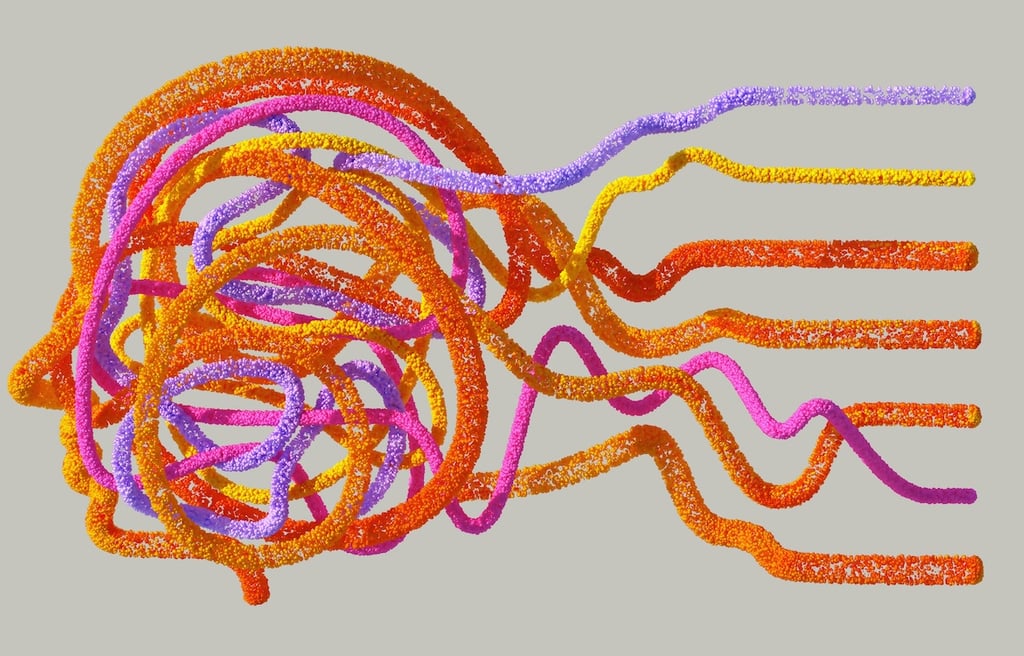THE NEUROBIOLOGY OF PAIN
A multifaceted and intricate field that delves into the mechanisms by which our nervous system detects, processes and responds to noxious stimuli.
Pain is a ubiquitous and essential aspect of the human experience, serving as a crucial alarm system that signals potential harm to the body.
The neurobiology of pain


The neurobiology of pain is a multifaceted and intricate field that delves into the mechanisms by which our nervous system detects, processes and responds to noxious stimuli. Understanding the complexities of pain at the neurobiological level is imperative for developing effective therapeutic interventions and advancing our knowledge of the mind-body connection.
PERCEIVING PAIN
The perception of pain involves a sophisticated interplay between the peripheral and central nervous systems. Understanding it, gives us the key to explore further the neurobiology of pain. We can summarise the process of the perception of pain as follows:
Nociceptor Activation
Detection of Noxious Stimuli
Nociceptors are specialised sensory nerve endings that are distributed throughout the body, especially in the skin, muscles and internal organs. These neurones are equipped with receptors that respond to specific types of noxious stimuli, such as heat, pressure or chemicals.
Transduction
When a noxious stimulus reaches a certain threshold, it triggers a series of molecular events within the nociceptor, leading to the generation of electrical signals. This process is known as transduction, where the energy of the noxious stimulus is converted into electrical signals.
Transmission of Pain Signals
Propagation of Signals
The electrical signals generated by the activated nociceptors travel along nerve fibres towards the spinal cord. These signals, often referred to as action potentials, are a form of electrochemical communication.
Release of Neurotransmitters
When nociceptive fibres reach the spinal cord, they release neurotransmitters, including glutamate and substance P. These neurotransmitters play a crucial role in transmitting the pain signals to other neurones in the spinal cord, initiating the process of nociceptive transmission.
Spinal Cord Processing
Nociceptive Transmission
The nociceptive signals ascend through the spinal cord, where they encounter various neurones. Excitatory neurotransmitters like glutamate enhance the transmission of pain signals, while inhibitory neurotransmitters like gamma-aminobutyric acid (GABA) help regulate and dampen the pain signals.
Modulation and Gate Control
The Gate Control Theory, proposed by Melzack and Wall, and which we discussed recently, suggests that non-painful input can modulate or "close the gate" in the spinal cord, inhibiting the transmission of pain signals. This modulation involves the interplay of inhibitory and excitatory signals, influencing the perceived intensity of pain.
Ascending Pathways to the Brain
Projection to the Brain
Nociceptive signals continue to ascend through the spinal cord towards the brain. As they reach higher brain centres, including the thalamus, the signals are further processed and relayed to various brain regions involved in the perception and interpretation of pain.
Brain Processing
The brain regions implicated in pain processing include the somatosensory cortex, insula and anterior cingulate cortex. These areas contribute to the sensory and emotional components of the pain experience.
Perception of Pain
Integration of Signals
In the brain, the nociceptive signals are integrated with other sensory, emotional and cognitive information. This integration results in the conscious perception of pain, encompassing its sensory qualities and the emotional and cognitive aspects.
Subjective Experience
The neurobiology of pain would not be complete by explaining only its objective processes. The perception of pain is a subjective experience influenced by factors such as attention, expectations and individual pain thresholds. Psychological and emotional factors (some of which we have described previously) can modulate the overall pain experience.
PERIPHERAL SENSITISATION
Peripheral sensitisation refers to the heightened responsiveness of nociceptors to noxious stimuli. In response to tissue injury or inflammation, various substances, including prostaglandins and cytokines, are released, sensitising the nociceptors. This heightened sensitivity contributes to the characteristic hypersensitivity associated with pain in injured or inflamed areas.
CENTRAL SENSITISATION
Central sensitisation is a key phenomenon in the neurobiology of pain, characterised by an amplified response of the central nervous system to noxious stimuli, leading to increased pain sensitivity. Several factors contribute to the development and maintenance of central sensitisation, and understanding these mechanisms is crucial for comprehending chronic pain conditions.
One key contributor to central sensitisation is persistent nociceptive input. Prolonged exposure to noxious stimuli, such as tissue injury or inflammation, can lead to a sustained release of excitatory neurotransmitters, such as glutamate and substance P, in the spinal cord. This continuous bombardment of nociceptive signals can result in the sensitisation of spinal neurones, causing an increased responsiveness to subsequent stimuli. This heightened sensitivity contributes to the maintenance of chronic pain even in the absence of ongoing tissue damage.
Another factor in central sensitisation involves neuroplastic changes within the central nervous system. Neurones in the spinal cord and brain undergo structural and functional alterations in response to persistent nociceptive input. This may include changes in gene expression, synaptic connectivity and neurotransmitter release. The reorganisation of neural circuits can lead to an amplification of pain signals and an aberrant processing of sensory information. Furthermore, dysfunctional descending modulation from the brain, particularly from regions like the periaqueductal gray and the rostral ventromedial medulla, can contribute to the perpetuation of central sensitisation by failing to adequately inhibit pain signals at the spinal level. Psychological factors, such as stress and anxiety, may also play a role by influencing the release of stress-related hormones and neurotransmitters, further contributing to the heightened sensitivity of the central nervous system to pain. Overall, central sensitisation is a complex interplay of neurobiological processes that result in an exaggerated and persistent perception of pain.
THE GATE CONTROL THEORY
Proposed by Ronald Melzack and Patrick Wall in 1965, the Gate Control Theory provides a framework for understanding how pain signals are modulated at the spinal cord level. According to this theory, non-painful input can inhibit pain signals by closing a "gate" in the spinal cord. For example, gentle touch or massage may activate non-nociceptive pathways, reducing the perception of pain. This theory has been instrumental in shaping our understanding of pain modulation in the neurobiology of pain and has influenced therapeutic approaches like physical therapy and acupuncture. You can read more about this theory here.
DESCENDING MODULATION
The brain plays a crucial role in modulating pain perception through descending pathways that influence spinal cord processing. The periaqueductal gray (PAG) and the rostral ventromedial medulla (RVM) are key brain regions involved in this descending modulation. These regions release neurotransmitters like serotonin and norepinephrine, which act on the spinal cord to enhance or inhibit pain signals. Dysfunction in these descending pathways is implicated in the development and maintenance of chronic pain.
Serotonin and norepinephrine are neurotransmitters that exert inhibitory effects on pain transmission. When these neurotransmitters bind to their respective receptors in the spinal cord, they activate descending pathways that suppress the activity of pain-transmitting neurones. This inhibitory modulation effectively closes the "pain gate" in the spinal cord, reducing the transmission of pain signals to higher brain centres. Dysfunction in these descending pathways can contribute to the development and maintenance of chronic pain conditions, as a diminished ability to inhibit pain signals may result in an exaggerated and persistent perception of pain. Medications that enhance the availability of serotonin and norepinephrine, such as the anti-depressants selective serotonin reuptake inhibitors (SSRIs) and selective serotonin and norepinephrine reuptake inhibitors (SSNRIs), are often used in the management of chronic pain to optimise descending modulation and alleviate pain symptoms.
NEUROTRANSMITTERS AND PAIN MODULATION
Neurotransmitters, such as endorphins and enkephalins (endogenous opioids produced by the body) bind to opioid receptors in the central nervous system, providing natural pain relief. Additionally, as we have just seen, serotonin and norepinephrine play roles in inhibiting pain signals, and their dysregulation is associated with conditions such as depression and chronic pain.
PLASTICITY IN CHRONIC PAIN
Chronic pain is often characterised by maladaptive neuroplastic changes in the nervous system. Structural and functional alterations occur in the brain regions involved in pain processing, leading to persistent pain states. Gray matter changes, altered connectivity and cortical reorganisation contribute to the chronicity of pain conditions. Understanding these plastic changes is crucial for developing targeted interventions to alleviate chronic pain.
GENETICS AND INDIVIDUAL DIFFERENCES
The experience of pain varies significantly among individuals, and genetics play a role in determining pain sensitivity and susceptibility to chronic pain conditions. Variations in genes encoding for neurotransmitter receptors, ion channels and inflammatory mediators can influence an individual's pain perception and response to analgesic medications. Unraveling the genetic underpinnings of pain could pave the way for personalised pain management strategies.
PSYCHOLOGICAL FACTORS AND PAIN
The interaction between the mind and body is a critical aspect of pain perception. Psychological factors, such as stress, anxiety and depression, can modulate pain through complex mechanisms involving the release of stress hormones and alterations in neurotransmitter levels. The biopsychosocial model of pain emphasises the importance of considering psychological and social factors in understanding and treating pain. You can read more about this our previous article here.
NEUROIMAGING IN PAIN RESEARCH
Advances in neuroimaging techniques, such as functional magnetic resonance imaging (fMRI) and positron emission tomography (PET), have provided valuable insights into the neural correlates of pain. These technologies allow researchers to visualise brain activity in response to painful stimuli, mapping out the intricate network of brain regions involved in pain processing. Neuroimaging studies contribute to our understanding of individual differences in pain perception and offer potential biomarkers for pain conditions.
THERAPEUTIC APPROACHES
The multifaceted nature of pain requires a diverse range of therapeutic approaches. Pharmacological interventions, including analgesics and anti-inflammatory medications, target specific pathways in the pain cascade. Non-pharmacological approaches, such as physical therapy, cognitive-behavioural therapy and acupuncture, aim to modulate pain perception through different mechanisms. TENS and Microcurrent therapy (such as Painmaster) have shown to be very effective in pain management, with very few (if any) side effects. Emerging technologies, such as neuromodulation and virtual reality, show promise in providing novel avenues for pain relief.
The neurobiology of pain is a dynamic and evolving field that continues to unravel the intricate mechanisms governing our perception of and response to pain. From the peripheral detection of noxious stimuli by nociceptors to the complex interplay of neurotransmitters and the plasticity observed in chronic pain conditions, our understanding of pain has advanced significantly. Integrating insights from genetics, psychology and neuroimaging, researchers and clinicians are working towards more personalised and effective approaches to pain management. As we delve deeper into the neurobiology of pain, we inch closer to developing targeted interventions that offer relief to those suffering from acute and chronic pain conditions.
SUBSCRIBE
Subscribe for updates on latest posts and to follow what is happening in the home of Target Pain.


